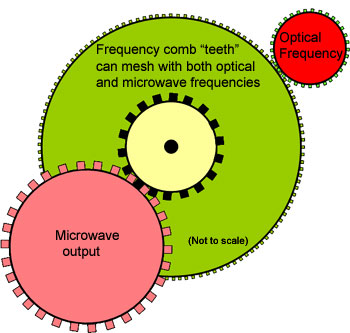Jul 8 2007
A super stable fiber-optic network that can be tuned across a range of visible and near-infrared frequencies while synchronizing the oscillations of light waves from different sources has been demonstrated at the National Institute of Standards and Technology (NIST).
 Frequency Combs as Gears of a Clock
Frequency Combs as Gears of a Clock
The flexible network design can simplify accurate comparisons of the latest atomic clocks operating at different frequencies and in different locations. The research also may have applications in remote sensing and secure communications.
Described in the May issue of Nature Photonics, the prototype NIST network demonstrates the first remote synchronization of light waves from two "frequency combs"—advanced laboratory tools for precisely measuring frequencies of light. The two combs have fine "teeth" marking precise frequencies in different but overlapping bands. If light waves at identical frequencies are merged, they can either overlap exactly or be "out of phase" (that is, their oscillations are at the same frequency but start at different times). Light waves at different frequencies never overlap exactly but, with great effort, can be made to overlap out of phase in the same patterns in repeated experiments. The NIST network is designed to do exactly that, thus reducing channel "noise" that would result from mismatches. The stability of the lasers and low "jitter" of the synchronized waves means the original signal character is always preserved.
The network also showcases record performance in a frequency comb produced from an erbium fiber laser, an alternative to the original frequency comb generated from a titanium-sapphire crystal, also developed at NIST. Scientists recently reduced the noise in the fiber-based comb enough to improve its stability 30-fold, achieving performance comparable to the state-of-the-art Ti:Sapphire frequency comb used as the second comb in the new NIST network. Fiber-based frequency combs have the potential to be more compact and less expensive; they also measure the lower, near-infrared frequencies of light that are used in telecommunications.
The prototype network spans three-quarters of a kilometer and connects three different laboratories on the NIST Boulder, Colo., campus. The designers say it could be extended to 50 km or more without any loss in performance. To showcase the capability of the two frequency combs (which operate on different principles) to precisely compare vastly disparate optical frequencies across great distances, both combs are stabilized by the same source of 1126 nm laser light, so that each tooth of each comb is locked to a single frequency. In addition, laser light at 1535 nm laser, stabilized by one comb, is compared to 1535 nm light generated from the second comb, and the stability of the beat frequency (representing the difference between them) is analyzed to evaluate network performance.